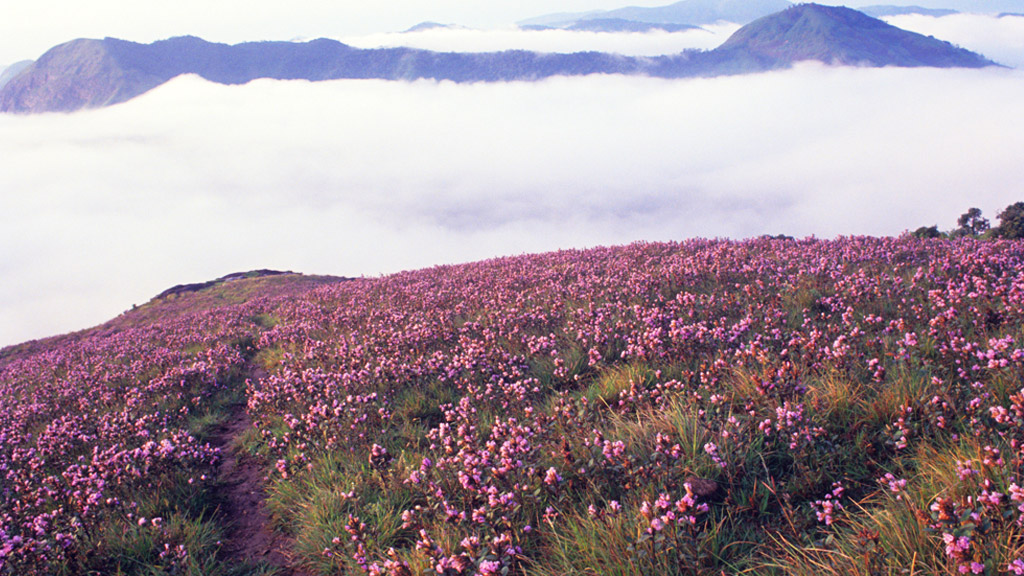"Dream, Dream, Dream! Conduct these dreams into thoughts, and then transform them into action."
- Dr. A. P. J. Abdul Kalam
"Dream, Dream, Dream! Conduct these dreams into thoughts, and then transform them into action."
- Dr. A. P. J. Abdul Kalam
9 Aug 2024
Over the past three days, images of a "Neelakurinji" bloom in the Bababudangiri range of the Western Ghats in the Chikkamagaluru district of Karnataka have taken over social media in India. Acanthaceae shrubs like the Neelakurinji are well-known for their yearly blooms, which occur once every 12 years. However, are Chikkamagaluru's blossoms truly Neelakurinji? These three researchers questioned them about the identity of the blooms; they are based in the Western Ghats. Additionally, news network Down To Earth showed them a few of the Chikkamagaluru photos that had been making the rounds online.
They believed that although some of the pictures indeed include Neelakurinji blossoms, others had Topli Karvy, another Acanthaceae family shrub. About 350 species of flowering plants in the Acanthaceae family belong to the genus Strobilanthes; these plants are primarily native to Madagascar and tropical Asia. According to Mandar Datar, a taxonomist at the Agharkar Research Institute in Pune, “the Topli Karvy (Strobilanthes sessilis), the Karvy (Strobilanthes callosa), and the Kurinji (Strobilanthes kunthiana), all belong to the Strobilanthes genus.”

(Source: Google Images)
About The Location ~
“The external resemblance of these flowers being taxonomically related, is very similar. People can often get confused,” he added. Of the four photos that DTE shared with Datar, he identified three to be Neelakurinji and one to be Topli Karvy. The Topli Karvy is found more in the northern section of the Western Ghats in Maharashtra. It is called so since it resembles an inverted basket, Jui Pethe, an ecological researcher, who works in the Maharashtra section of the Ghats, told DTE.
“The Karvy (Strobilanthes callosa) grows on the steepest cliffs where trees can’t grow. The Topli Karvy grows on the plateaus of the northern Western Ghats on the other hand. The Neelakurinji on the other hand grows in the shola grasslands of the southern Western Ghats, which are not found in Maharashtra,” Pethe stated. Godwin Vasanth Bosco, restoration ecologist author of the book Voice of a Sentient Highland on the Nilgiri Biosphere, said the Neelakurinji was endemic to the southern Western Ghats and higher reaches of the Eastern Ghats.
There are about forty kinds of Neelakurinji, also known as 'Strobilanthes kunthiana', most of which have blue flowers. is a term that means "blue," and the local tribes call it "kurinji." The best time to see them is from August to October; they were last spotted in 2006. This magnificent sight is seen from Kovilur, Kadavari, Rajamala, and Eravikulam National Park in Munnar. The majority of the planet's remaining population of the endangered Nilgiri Tahr is, incidentally, found in Eravikulam.
Experience the Magic of Neelakurunji ~
Both botanists and lovers of the outdoors mark their calendars for this occasion. Being in the middle of the Neelakurinji is like being in a different dimension. The shorter variation (about 2 feet) is visible at higher points, whereas the longer variants (around 5 to 10 feet) are seen at lower spots. Treks are planned to see this natural marvel during this time of year, and specialized excursions of this uncommon phenomenon are available nearby. Allotted just once every twelve years, it's like a private peek into heaven!